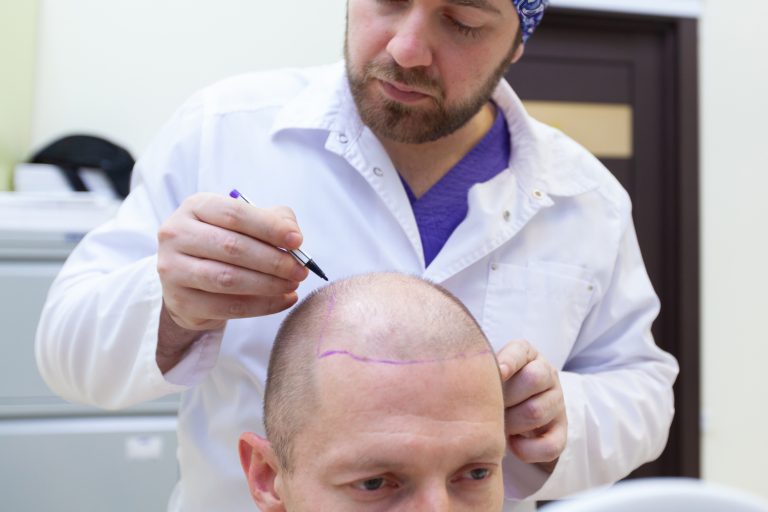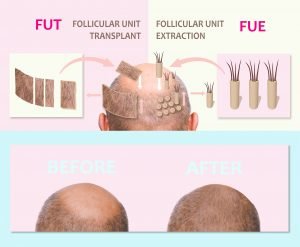
Page Contents
If your hair simply won’t grow, then perhaps you may be thinking about a hair transplant. Some people may look good even without much hair, but most people simply don’t. A lack of hair is nothing to be ashamed of, and yet baldness can be embarrassing.
When no other hair loss treatment seems to work, you may start looking at something like hair transplants. But what exactly is a hair transplant? Is it something that might be right for you, and can you even afford it?
How Is A Hair Transplant Done
As technology has improved, so has the methods of doing hair transplants. Originally, getting hair plugs was something that often didn’t look natural. Old references to ‘hair plugs’ are due to the punch graft method.
For this, doctors would remove a small circle of hair from the donor area of between 12 to 30 follicles. This would then be grafted into place in the desired area, but the result looked less than smooth.
Today, there are two popular ways that a hair transplant can be done. These two types are often abbreviated as FUT and FUE, which stand for Follicular Unit Transplantation and Follicular Unit Extraction.

The FUT method takes a strip of your scalp from where your hair is growing healthy. This strip is about 6” to 10”, and it is then divided up into follicle clusters and placed in the area you want to have your hair. This can leave a scar from where the strip was taken, however.
This is why the strip is often is taken from the back of the scalp. To hide the scar, most people keep simply keep their hair slightly longer. This scarring can be a problem for those who prefer to keep their hair short, however.
The other method, FUE, is much more detailed. FUE involves taking individual hair follicles from an area on your scalp where they are growing well. These hair follicles are then put into the area of your scalp where you want them.
The FUE process requires work on a microscopic level, so the little scaring it does leave behind is equally small. It also takes much a much longer process to do a smaller area, but many consider it to be well worth it. Finally, new transplant methods using robotic parts are starting to arrive.
The Breakdown Of Hair Transplant Costs

Altogether, the cost in the US of a hair transplant can range from anywhere between $2,000 to $20,000. There are many factors about hair transplants that can affect the cost. Each cost factor will either add to the cost of the hair transplant or can possibly make it cheaper.
It takes looking at all of this together to see what it might cost you. While you want to get a consultation with the dermatologist you have in mind, there will be a consultation fee. This consultation fee may or may not be counted later as a part of the procedure.
The Type Of Transplant And Amount Of Hair
This first factor is which type of hair transplant you decide to go with. The FUE is more popular, for some pretty obvious reasons, and doctors often charge per graft for this one. The per graft price can range from $2 to $10.
The use of mechanical robots to do hair transplants is very new, and it is also very expensive. Once it is perfected, mechanical hair transplants may eventually become cheaper than having to have a doctor manually do the procedure. However, until then, mechanical hair transplants are actually more expensive.
Then, there is also just how much hair you are trying to move around as well. After all, the more hair you want transplanted, especially using the FUE method, the more time it is going to take the surgeon. So, a larger hair transplant is going to cost more for obvious reasons.
However, since some of the cost goes to prepping you for the procedure and other stuff, the longer sessions tend to be cheaper per hair follicle. So, a short session where 200 hairs follicles are transplanted can sometimes cost as much as $2,000.
Longer sessions where more grafts are done tend to be slightly cheaper per graft. If you want a long session where thousands of hairs are transplanted, you are more likely to get something closer to the $2 per follicle price. This can make getting 5,000 hair follicles moved cost $10,000 compared to the $2,000 for 200 follicles.
Finally, depending on how much hair is being transplanted, you may need general anesthesia instead of local anesthesia. Local anesthesia is cheaper because general requires a professional anesthesiologist.
Location
Where you live can also affect hair transplant costs. In fact, it is possible to find maps that show that some states have an overall higher cost for this than other states. Even inside a state, the number of licensed surgeons in your area that can do a hair transplant will affect the price as well.
Besides the state difference, each country has its own price for hair transplants as well. A few other countries try to make themselves good places for medical tourism for hair transplants. Turkey is a favourite place as is India and Dubai for hair transplant.
Where there is competition, the cost of hair transplants drops. Also, hair transplant specialists with more experience and a better success rate than average will often charge more.
In both India and Turkey, there are literally hundreds of different clinics for this. This is why the FUE price for a 4,000 follicle procedure can be as low as $2,000. You can guess why thousands of people travel all that way for the procedure.
Considering this, you may want to travel to see a transplant specialist further away who might have a cheaper rate. In this case, don’t forget to factor in the costs of not only your travel but wherever you are staying.
The Aftercare
After getting your hair transplant, that is not the end, even though you usually go home the same day. You will need to go back to see the surgeon, who will want to check and verify that you are healing properly. These visits will cost you as well, both for the visit itself, and for the gas to travel there.
You will also have medication that you are supposed to take, which you will have to pay for. The doctor applies a numbing agent for the procedure itself, but you need pain medication for after the fact. You also are likely to be given both an antibiotic and an anti-inflammatory prescription to fill.
May doctors doing hair transplants also prescribe minoxidil or something else to help encourage the hair to grow in the new location. Besides that, certain products that help with healing after a transplant may be something that you want to buy too.
If you are going with the FUT method that scars, you may want to invest in a few hats. Sunlight can increase scarring, and you are probably going to want hats that are loose so as not to hurt your healing scalp by putting pressure on it.
Your dermatologist is probably going to recommend a scent-free gentle shampoo for your hair, which will need to be bought. And you may need to buy a special gentle brush, if they tell you that you can brush your hair at all.
Other Things
Besides the hair on your head, there are hair transplants for other areas too. These specialized transplants tend to cost more, but they can help with your eyebrows, beard, or hair in other places if you want it.
The recovery for a hair transplant takes a week or two as far as the pain goes. The pain is at its worst for the first few days, so you may not be able to return to work for a few days after your transplant. This can cost your next paycheck.
As for the hair follicles themselves, that takes quite a bit longer. The area the doctor is working has to be shaved, first of all, and the transplanted hair will be shocked by the change into entering the dormant stage. This means that the moved follicles will soon fall out.
Then, if anything about the hair transplant goes wrong, such as getting an infection or the graft not healing right, you will have to have more visits, more medications, and more expenses. You may also need to start putting products in your hair that you didn’t need to use before in order to make your hair look more natural.
Finally, many hair clinics offer help with financing and payment plans. These can help take the cost of transplants down a little so that you can get the help you need.
When To Consider Getting A Hair Transplant
Hair transplants are often thought of as a last resort sort of thing. If you have tried everything else, then that is a very good reason alone to consider getting a hair transplant. However, there are several things that might make a transplant wrong for you.
Unfortunately, getting a hair transplant is mostly suited for those who still have at least a fair amount of hair. If you are completely bald on top and only have a little hair around the edges, then it is too late for you. Remember that you are only taking hair from one area and putting it somewhere else.
Also, you want your current hair loss to be stable. After all, if you are still losing more hair, then you could end up with hair in the back and on the top, thanks to the transplant. But missing hair in a ring around this top area is not going to look right.
More than that, the hair that just got transplanted is also more likely to fall out or not grow at all if you are still actively losing hair. This is why younger people don’t often get hair transplants, and doctors of this sort don’t recommend it for men or women still in their 20s.
In fact, some doctors will all but refuse to do transplants for those that don’t have a severe enough case of hair loss or who are currently losing hair. Instead, these hair doctors are far more likely to recommend other treatments and ways to get the loss under control.
Finally, consider if you are willing to stop smoking as well. For whatever reason, smoking tends to cause complications to be more likely. So, you are asked to stop smoking at least two weeks before getting a hair transplant.
Disadvantages Of Getting A Hair Transplant
There are many disadvantages of getting a hair transplant. The most obvious is the price of getting one done. This cost is especially a lot because hair is considered cosmetic as is, therefore, not covered by insurances.
Then, hair transplants really don’t fix anything at all if you think about it. It doesn’t make more hair grow; it simply moves your growing hairs around. Though this makes your hair look a little fuller, it also kills a few of your hairs while it is at it.
Next, there is the not-so-small fact that getting a hair transplant is no guarantee that your hair will grow where you want it to. There is a possibility that you can get the transplant done and that it fails for whatever reason. The area where you take the follicles from will never grow them back again.
You won’t even know if the transplant is truly successful until months down the line. In the meantime, having your hair enter the dormant stage for a while will hardly be encouraging. In fact, your scalp will look worse off for a while than it did before your procedure.
Finally, though going to a place like Turkey to get your hair transplant done cheaper might seem like a great idea, it might not be. One reason why Turkey is able to do this procedure is because they have fewer regulations.
With so many hair clinics, what regulations they do have are sometimes not followed. There are plenty of instances where nurses and technicians do the procedures instead of the doctor. That is a big hair risk to take.
The Side Effects
Besides all of that, hair transplants are a type of surgery, which is something you should keep in mind. Like any surgery, transplants like this are going to have possible side effects. You may have no side effects at all, or more than one.
Post-Surgical Edema is one of the more common hair transplant side effects. Edema being a build-up of fluid and minor swelling, it is not the worst side effect, though far from pleasant. Over 30% of patients have this side effect to some degree, but it usually rectifies itself after a few days.
Hemorrhaging is a slightly less common side effect. This bleeding can be either more or less serious, depending on just how much blood you lose. However, if the doctor is good, then there technically shouldn’t be any of this.
Then, sterile folliculitis and Lichen Planopilaris (LLP) can also happen. These are forms of scarring and inflammation, the latter occurring when excessive scar tissue forms at the transplanted area. The former is mild, includes some itching, and many have a small amount of this side effect. However, LLP, though rare, can worsen or even cause hair loss.
Itching is another common thing for hair transplants. Unfortunately, itching will remove the hundreds or thousands of tiny scabs and will make it take that much longer for your scalp to heal. Scratching too much may also very well damage the follicles that got moved.
This causes more scarring, and sometimes the FUT transplant process can cause raised scarring. Numbness might not be a big deal, but it can be uncomfortable if it lasts for longer than a week. The numbness is not common, but some get it as their body adjusts to the transplant. Finally, cysts may form, but usually resolve themselves in a week or two.
Other Options And Things To Consider

There are so many hair loss treatments and methods that you can try. Many of these work wonders, which is why hair transplants are often thought of as a last resort. However, even if you get a hair transplant, you may want to do some of these as well to encourage the new hair to grow.
Low-Light Laser Therapy (LLLT) is one that your dermatologist can do, or you can do it at home. You can buy a laser cap for a few hundred dollars for you to use yourself. This is cheaper in the end than going to your dermatologist’s office and having to spend often thousands of dollars for a few sessions there.
Microneedling is much the same. You can microneedle at home yourself for much less cost than having your dermatologist do it. However, you should have them microneedle you the first time or two, so you know how much pressure to use. There is no point buying your own derma roller if it makes you too uncomfortable.
Final Thoughts
Millions of people in just the US have hair loss. Though severe hair loss affects men more than it does women, it is still a huge problem. It is because of this that hundreds of thousands of hair transplant surgeries are done every year.
Even many celebrities have had hair transplants, though exactly how may is something that no one may know. Many women with just a little thin hair can have a small amount of transplants done into their part line for some amazing results.
However, a hair transplant is not something that should be done hastily. It can take up to a year to recover from it, and it only covers up the problem without solving it. Then, as you get older, you may lose more hair and need more work.
If you are looking for a surgeon to do a hair transplant for you, you want one that is certified by the American Board of Plastic Surgery or the American Board of Dermatology. Both organizations do have a free referral service, and the American Hair Loss Association has a guide you should look at.
This guide tells you how to check a surgeon’s credentials. The American Hair Loss Association also has a list on their site of outdated hair transplant procedures. These are procedures that you should avoid. All three of these are very helpful and are great places to start.








Such a great article and the cost breakdown was very well explained. Thanks for sharing!